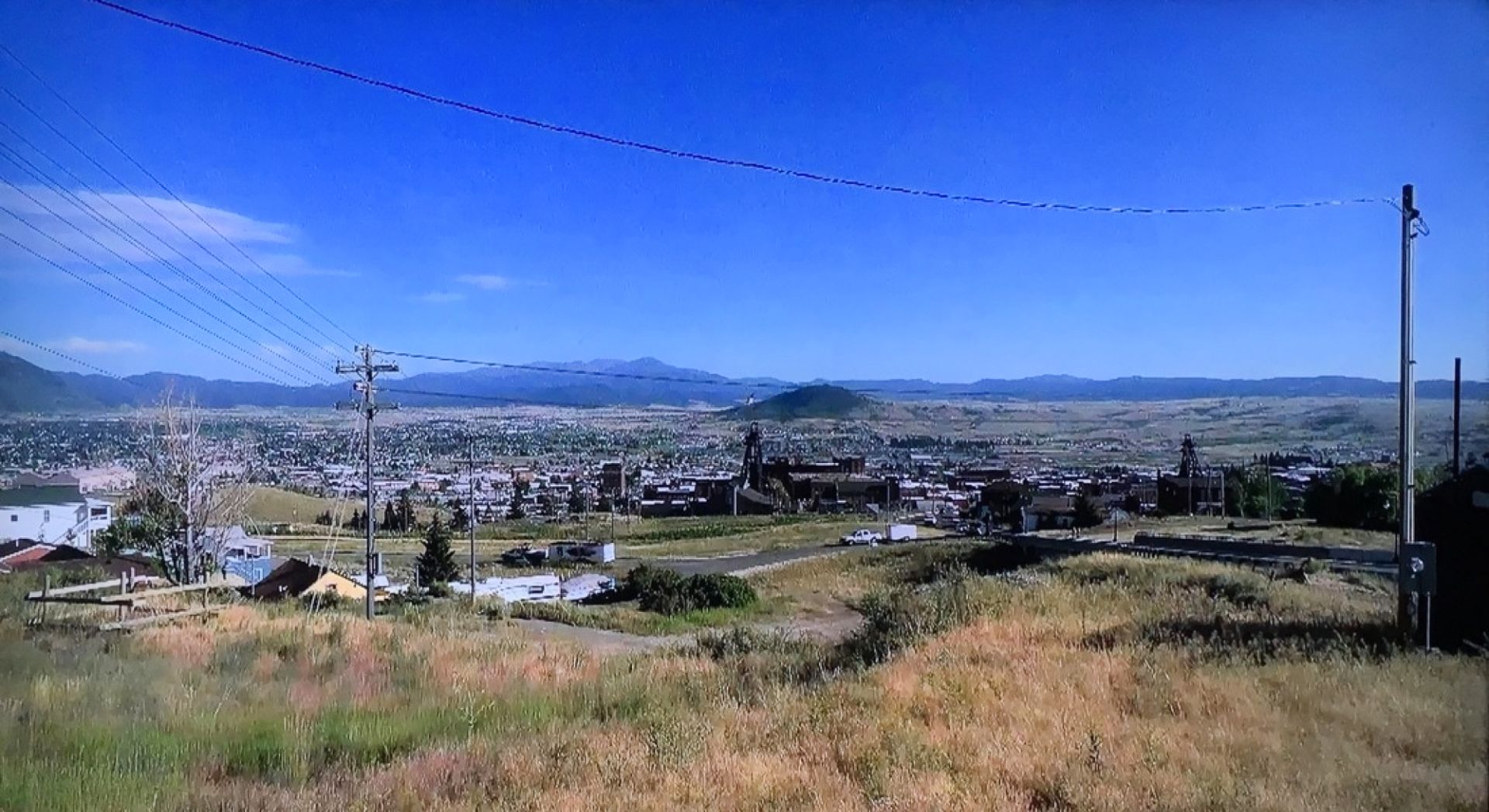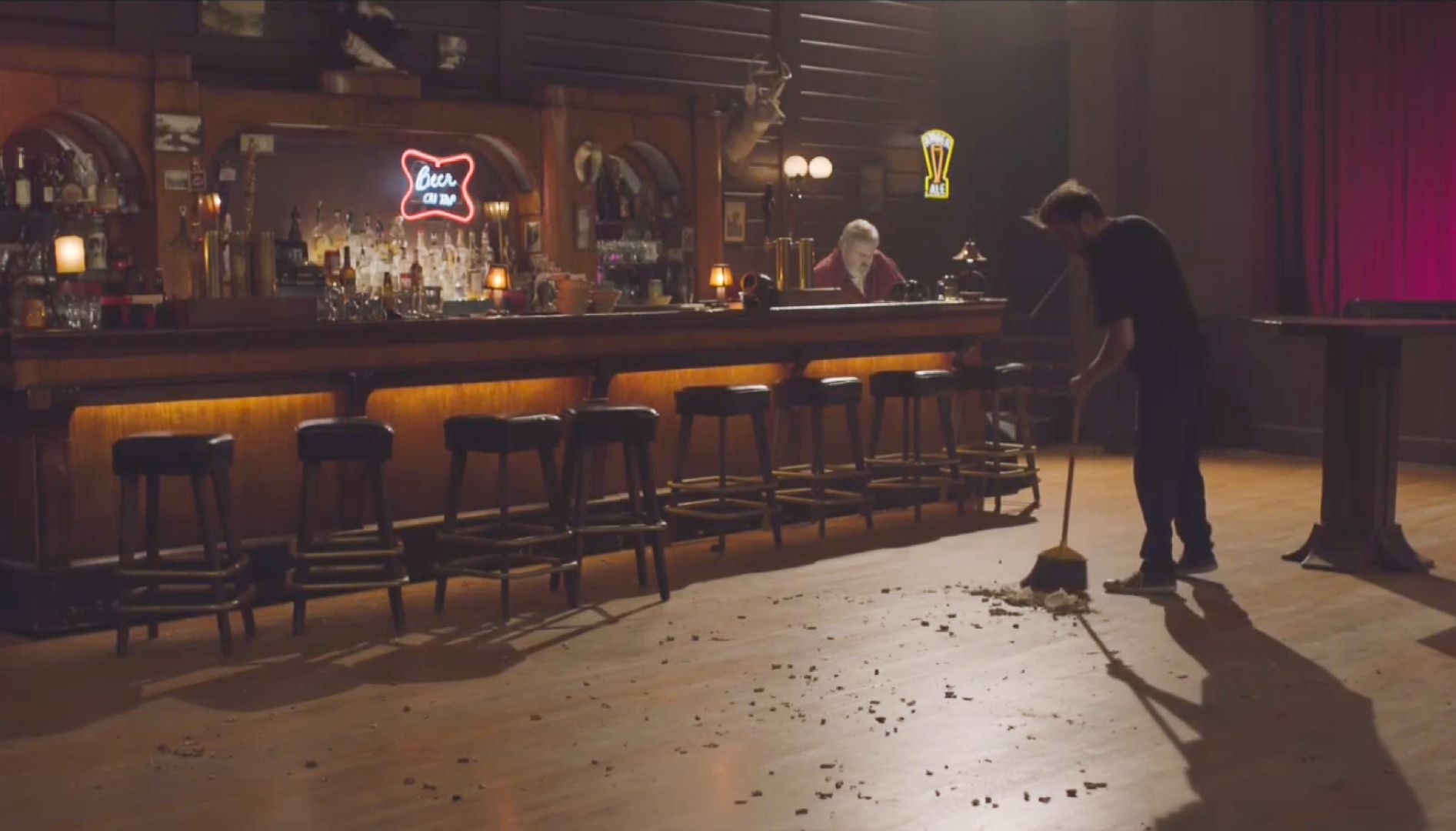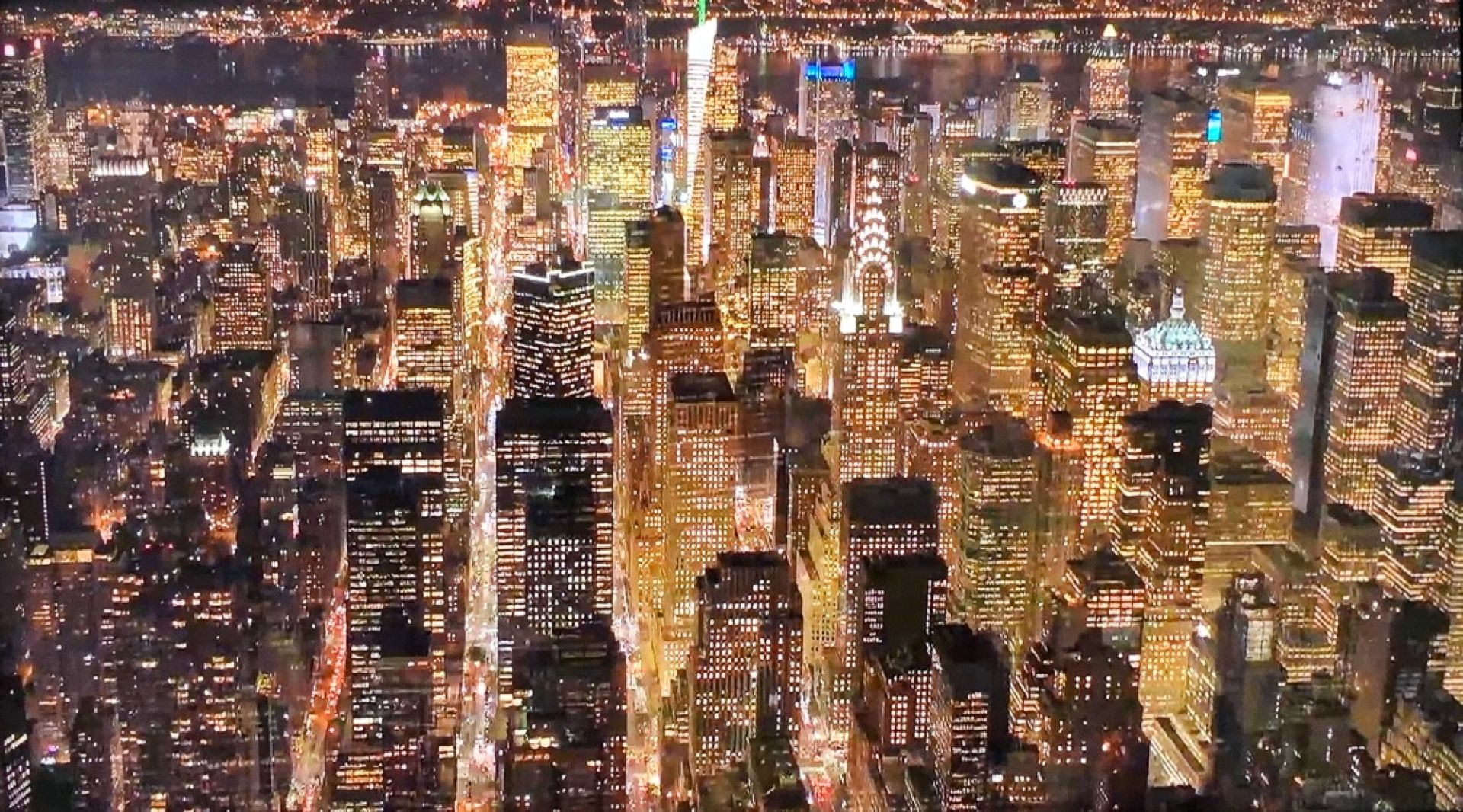David Lynch Sprawls
by Richard Martin
Published February 2020
Abstract:
Lasting eighteen hours and featuring umpteen locations, Twin Peaks: The Return spreads out across time and space in a manner rarely seen in David Lynch’s work. In short, it sprawls. This article explores how sprawl might be a useful term through which to assess the series and how Lynch positions sprawl as a productive mode of thinking, despite the negative associations the term usually evokes. Via the theories of junkspace developed by Rem Koolhaas and junktime coined by Hito Steyerl, the article also attempts to analyze the extraordinary experience of watching The Return.
“My family, my friend, I have criss-crossed this great land of ours countless times. I hold the map of it here, in my heart, next to the joyful memories of the carefree days I spent as a young boy, here in your beautiful town of Twin Peaks. From Alexandria, Virginia, to Stockton, California, I think about Lewis, and his friend Clark, the first Caucasians to see this part of the world. Their footsteps have been the highways and byways of my days on the road. My shadow is always with me, sometimes ahead, sometimes behind, sometimes to the left, sometimes to the right, except on cloudy days, or at night.”
—Wally Brando
Motorcyclist Wally Brando’s monologue in episode four of Twin Peaks: The Return (2017), performed with care and sincerity alongside his adoring parents, fast became a favorite moment for many fans of the series, inspiring memes, artworks, and other online tributes. In the midst of a dark, slow-moving, and apparently random succession of events, the scene felt like light relief—a brief, blissful respite from complete confusion. Yet, as ever with David Lynch, we should take most seriously those moments that appear to be most frivolous. For Wally’s cameo speaks to the defining features of The Return: its hugely increased scope, its desire to map a terrain far beyond a single small town, its ambition to take in an entire nation, to drive, fly, and wander from coast to coast, highways to byways, at its own, highly irregular pace. In short, The Return sprawls; it spreads out across time and space in a manner rarely seen in Lynch’s previous work.
This essay explores how The Return sprawls and what sprawl might mean. I’m interested in the numerous spaces and places the series shows us and the psychological states that particular locations evoke. In so doing, I want to relate something of the extraordinary experience of watching The Return—to consider how it encourages a viewer to think and feel in strange, unconventional ways. How might this epic extension to the Twin Peaks project relate to an American history and an American geography that Lynch has been plotting throughout his career?
The original Twin Peaks series began with a map—a drawing of a small community in the woods created by Lynch as a blueprint for potential storylines (Rodley 158-159). In the first two series and in the film Twin Peaks: Fire Walk with Me (1992), the action is almost entirely confined to this town. Indeed, this has been a strength of Lynch’s best work: the intense focus he places on a single, bubble-like location—think of Henry’s tiny room in Eraserhead (1977), with its humming radiator and severe claustrophobia, or Lumberton in Blue Velvet (1986), where we join Jeffrey Beaumont in discovering hidden thrills beyond billboard perfection. Lynch excels at tightly constructed environments—in creating small, intricately detailed worlds. In a typically astute observation, David Foster Wallace once likened Lynch to “the type of bright child you sometimes see who’s ingenious at structuring fantasies and gets totally immersed in them but will let other kids take part in them only if he retains complete imaginative control over the game and its rules” (Wallace 151-152).
In The Return, the game—and whatever rules govern it—now operate across a vastly expanded board. While we occasionally occupy familiar Pacific Northwest locales like the Double R diner, the Roadhouse, and the Great Northern Hotel, we’re more often transported far beyond Twin Peaks to the neon lights of Las Vegas or FBI headquarters in Philadelphia, to a glass cube in New York City and a black box in Buenos Aires. We spend time in Buckhorn, South Dakota—much to Albert’s dislike—and inside the Pentagon in Arlington, Virginia.

We travel to the Nevada desert, where the bodies are buried, and to White Sands, New Mexico, where the bomb was tested. There are brief trips to Montana, Utah, and to a sinister diner in Odessa, Texas. Even east London is evoked through the unforgettable character of Freddie Sykes, who seems like a descendent of the Victorian cockney crew last seen in Lynch’s The Elephant Man (1980).
This is a grand journey to fill Wally Brando with pride. But it’s also indicative of a world escaping and exceeding its usual boundaries, spilling out in unexpected directions at uneven speeds. The Return often feels messy and chaotic. So many US states and so many states of viewing—sadness, frustration, terror, boredom, confusion, hilarity. As the critic Sarah Nicole Prickett noted, in the most perceptive of the many online episode-by-episode responses to the series, in The Return “worlds diverge and are weirdly, sparsely populated” (Prickett). If the original Twin Peaks was characterized by a strong sense of place, The Return often seems to emphasize placelessness.
Why might sprawl be a useful term to understand The Return? To sprawl, in the OED’s definition, means to “be stretched out … in an ungainly or awkward manner.” This feels like a very Lynchian posture. From his early short film, The Alphabet (1968), which declared, “Please remember, you are dealing with the human form,” Lynch has always paid close attention to strange bodily contortions. Think of the impossibly swaying, dying figure that Jeffrey discovers at the end of Blue Velvet, or the mutated croaking flesh that Henry fathers in Eraserhead. As the novelist Tom McCarthy has argued, “Deformity, for Lynch, is never thematic.” Rather it is “instrumental,” producing “a whole prosthetic order … an ontological condition” (McCarthy 135). What’s more, for Lynch, our bodies always have an intimate link with technology, a “persistent biologizing of media,” as Justus Nieland puts it (Nieland 113).
This is of particular significance for the world of Twin Peaks. For television sprawls, and sprawling is what we do while we watch it. Films are tight and compact, just as cinemas provide a focused, upright architecture for our viewing. Television, however, and especially television in an age of streaming and box-sets, is looser and open-ended. It induces guilty feelings of laziness, wasted time, and low-grade consumption. It evokes slouching and bingeing on a couch in slumbering states of fragmented attention.
Sprawl also has a distinct and relevant architectural definition, summarized by the OED as “the straggling expansion of an indeterminate urban or industrial environment into the adjoining countryside.” This is territory beyond traditional spatial terms such as city and suburb. As urban historian Dolores Hayden explains in her Field Guide to Sprawl (2006), we need a new language to analyze big box stores, fast food outlets, strip malls, junkyards, billboards, remote prisons, and themed restaurants—all, we might note, the kind of “indeterminate” locations seen in The Return. These built forms also provoke an ungainly physical response: when we see sprawl, Hayden says, “we react with sagging shoulders and clenched jaws.” “The visual culture of sprawl”, she adds, “should be read as the material representation of a political economy organized around unsustainable growth” (Hayden 10-13).
Sprawl, then, has a bad reputation. No one has a good word to say about it. As Robert Bruegmann notes in Sprawl: A Compact History (2006), “most of what has been written about sprawl to date has been devoted to complaints” (Bruegmann 3). Sprawl, to its critics, is undisciplined and inelegant. It occupies time and space with ugly, disorganized forms. It scatters and wastes resources in a careless fashion. It’s bad for the environment, and for our lazy, stretched waistlines.
Before considering how we might examine The Return in this context, there are two further concepts that provide a productive framework for understanding Lynch’s latest work. The first of these was famously outlined by the Dutch architect Rem Koolhaas in his own sprawling essay: “junkspace.” “Junkspace” describes the soulless spaces of purgatory that now dominate our environment: corporate lobbies and convention centers, shopping malls and parking lots. Such spaces represent “the fallout” of modernization, Koolhaas suggests—sterile, generic, and “a new gospel of ugliness” (Koolhaas 175-190).
More recently, the artist and theorist Hito Steyerl has written about “junktime”—an experience of the world as “wrecked, discontinuous, distracted” (Steyerl 21-29). Junktime, she explains, is “exhausted, interrupted, dulled by ketamine, Lyrica, corporate imagery” (24). In a passage that feels extraordinarily relevant to The Return, Steyerl claims:
If you tend to be in the wrong place at the wrong time, and if you even manage to be in two wrong places at the same wrong time, it means you live within junktime. With junktime any causal link is scattered. The end is before the beginning and the beginning was taken down for copyright violations. (24)
Watching The Return often involves a similar sense of fragmentation and disconnect, as we encounter characters who always seem to be in the wrong place at the wrong time. The series is defined by temporal confusion, interrupted storylines, maddening breaks with narrative cause and effect, and a severe dulling of conventional screen momentum. It climaxes with a digitally-amended ending that loops back to undermine the very origins of the entire project. Such discontinuity might have been heightened depending on the initial viewing conditions. Did you sign-up for a special subscription, rip-off a friend’s account, or watch a grainy, illegal stream? Was your experience wrecked by buffering and low-grade sound? Maybe, you didn’t notice. Or perhaps you waited for the DVD boxset and had to endure many fearful months in which absent-minded scrolling or stray clicks might lead to a crushing spoiler. It’s certainly not clear how any viewing experience of The Return could match the demanding cinematic screening conditions Lynch has often promoted for his films.
Yet, The Return also feels resistant to junktime. It demands our full attention and close scrutiny of its detailed and disorientating world. The images may lack the digital sheen of other contemporary television series, but they throb with imagination. Still, if you pay attention throughout the eighteen episodes of The Return expecting to be repaid with resolution, then you’ll be grumpy and disappointed by the conclusion.
So, a sprawling landscape, filled with junkspace and governed by junktime: does this describe the third series of Twin Peaks? Let’s consider the locations we visit in The Return. A trailer park where residents sell blood plasma for rent; a federal prison which looks like an Ikea store; endless shacks and dives and dingy interiors; long, straight roads through flat plains; car dealerships and filthy garages; shiny corporate offices with glass walls, leather chairs and pained expressions; “a fucking morgue” where you can’t even smoke, as Diane discovers. It’s America, but it could be anywhere. “When you get there, you’ll already be there,” as they say in the Red Room. The locations seem mundane but also strangely significant, and all are shot in the harsh, stark clarity of digital, where the original two series were soaked in warm, inviting film.
One particular location stands out as a literal manifestation of urban sprawl: Rancho Rosa, the desolate suburban scheme where Dougie lives, which also lends its name to the production company behind the series.

This double-R development lacks all the charm of its Twin Peaks counterpart. Rancho Rosa, we’re told, is a six-to-eight-dollar cab ride from the Vegas strip, but there’s no casino glamour here. Surrounded by a high brick wall and framed by a grubby billboard showing smiley white faces, Rancho Rosa is a post-crash nightmare: rows of uniform non-descript houses, only distinguishable by the color of their front doors, divided by wastelands and potholed roads. It’s a place for insurance salesmen to meet prostitutes and hitmen to hang out—for drug addicts to fester and for homeless people to roam with shopping trolleys. “Someone manufactured you,” we might say to these deadening homes where foreclosure looms heavy. Even a car bomb can’t liven up its drained, exhausted atmosphere. There’s nothing rosy here, nor any trace of a ranch. A palpable—if deeply flawed—notion of community bound the original Twin Peaks; in The Return, no such assumption exists.
Dougie, bless him, looks at his suburban life as if it’s the strangest, funniest thing in the world, which perhaps it is. He lives in his own kind of junktime: a painful, ungainly zone of borrowed gestures and awkward movements. Beyond Rancho Rosa, he’s forced into the junkspace of Lucky 7 Insurance, loitering in a privatized plaza after a day spent on the beige carpets of his plush, mind-numbing office. What would this environment look like if you’d come from another world? One thing that’s certain is that it wouldn’t feel lucky.
An innocent visitor might also ask: what produced this sprawling landscape? Lynch gives us a typically oblique answer in The Return. Episode eight of the series begins on the highway system then switches to the event that generated it: the first dropping of the atomic bomb in 1945, the birth of a new world. As Lynch’s camera moves slowly towards the billowing explosion, we’re immersed in its unfurling chaos of noise, dust, and fire. It’s a catastrophe that’s both deadly and generative—a shocking, shattering interruption and the ultimate glitch in space and time.
In the United States, there were twin architectural responses to the nuclear age. There was a passion for domes, epitomized by Buckminster Fuller and Shoji Sadao's famous 1960 proposal to encase midtown Manhattan—a desire to contain and shelter citizens, huddled together for protection. At the same time and propelled in legislative terms by the 1956 Interstate Highway Act, there was the development of an elaborate national highway system, which would separate and scatter people in suburban developments, while allowing weapons to move around at high speed. Gordon Cole has a large picture of a mushroom cloud in his FBI office, and Henry in Eraserhead has one pinned to his wall, too. As ever with Lynch, history is manipulated and reworked in unexpected ways. The bomb reordered minds and worlds, The Return suggests, and that reordering was messy and complex, its consequences spawning, sprawling, and uncontrollable. Lynch’s account of American geography contains no straight stories.
If the scattered locations of The Return might be seen as spatial sprawl, then the series also sprawls across time, its eighteen hours creating a form of durational aesthetics. Those hours are defined by slowness, a constant feeling of decoys and delays, which are often infuriating, sometimes unbearable, frequently hilarious. Everything takes too long in The Return. Scenes are stretched way beyond conventional televisual length: a barman sweeps the roadhouse floor forever, a French woman just can’t leave Gordon’s hotel room, Audrey and her husband have interminable conversations.

We seem to wait an eternity for Dougie to reawaken as Agent Cooper. Twenty-five years in the making, The Return is determined to highlight the experience of time passing.
The sprawling form of The Return gives it a unique feeling of fullness, a straggling expansion into new indeterminate zones. There’s endless “room to dream,” to borrow the title of Lynch’s recent memoir. We have extended access to secondary or tertiary characters; we hear in full the carefully-curated Roadhouse playlist at the end of each episode; we can study at length Harry Dean Stanton’s extraordinary face. Such temporal sprawl can feel discomforting, but it also allows us thinking space between the intense and often violent encounters that pepper the series. Moments of quiet tenderness, longing, and sadness emerge. A project shadowed by illness and death—of cherished friends and long-term collaborators—is generous with its mourning process.
In this respect, the series makes the case for sprawl as a productive mode of thinking, especially when encountering the intricacies of a director’s long career. Sprawl might offer a sense of getting lost in a world or of living with chaos and fragmentation. As a late work in the Lynchian canon, The Return provides its creator and his dedicated audience with ample space and time to imagine unexpected connections with past works. What else might link Henry and Gordon Cole, beyond an interest in the bomb? Perhaps Freddie’s epiphany that his true destiny lies not in London but in Washington State suggests that Twin Peaks is somehow linked with the Victorian world of The Elephant Man. By this point in Lynch’s life, the potential for critical cross-referencing and dreamy speculation are rich. As such, we might think of sprawl as a form of free association, allowing both spectators and filmmakers to explore memories and make imaginative connections.
There’s a broader sense in which sprawl might help us approach Lynch’s varied output across six decades. Responses to his work often pivot on questions of control and authority. Is watching Lynch about letting go, losing your inhibitions and immersing yourself in visual and aural experimentation? Alternatively, is watching Lynch about maintaining a sharp, focused critical eye, noting clues and symbols, drawing connections, and nodding at the cultural references? Sprawl seems to transcend this divide. With its spatial and temporal expanse, with a plot that invites theories but is impossible to summarize, The Return asks us to think in a different way. In many respects, The Return acts as a summary of Lynchian obsessions—combining chunks of his work from art school and Eraserhead to Inland Empire (2006) and his online experiments. While this is true, it shouldn’t stop us from confronting what’s radically new here and the challenges it poses.
To finish, though, let’s return to the opening of the series. Of course, with Lynch, and with the Twin Peaks project in particular, we’re never far away from a shadow or a double or a doppelgänger. There’s one clear antithesis of sprawl in The Return: the densely packed New York cityscape Lynch introduces in episode one with one of his hypnotic aerial shots.

Inside a loft high in an ominous tower, we see the now-familiar symbols of urban artistic creativity: remnants of industrial labor via a clanking lift, exposed brick-work, and peeling paint, now housing a highly choreographed group of cameras trained on a glass cube, supported by an elaborate server. It’s the perfect location for contemporary performance, and we have a select audience waiting for something to happen, unsure what might occur. It’s also the perfect spatial metaphor for everyone watching at home, suspended on their sofas in anticipation. We expect avant-garde experimentation to take place in a location like this—a gentrified warehouse space in a hip urban center.
But once this cube has unleashed its grisly spirit, the loft is not a location where Lynch wants to linger. He barely bothers to return. Turn your attention to other highways and byways, the series suggests. Get out of New York and criss-cross this great land. It’s a restless, sprawling spirit epitomized by the good wishes given to Wally Brando: “May the road rise up to meet your wheels.”
Acknowledgements
This essay was originally written for the conference Freud/Lynch: Behind the Curtain, organized by the Freud Museum and held at the Rio Cinema, London in May, 2018. Many thanks to Jamie Ruers and Stefan Marianski for their kind invitation to contribute to the event and to the many speakers and audience members who offered generous and valuable responses. Thanks also to Matthew Lau and Matt Miller for their supportive and constructive comments as the essay evolved.
Works Cited
Bruegmann, Robert. Sprawl: A Compact History. U of Chicago P, 2006.
Hayden, Dolores. A Field Guide to Sprawl. W. W. Norton & Co., 2006.
Koolhaas, Rem. “Junkspace,” October, vol.100, Spring 2002, pp.175-190.
Lynch, David. Room to Dream. Canongate, 2018.
Lynch, David, director. The Alphabet. David Lynch, 1968.
---, director. Blue Velvet. De Laurentiis Entertainment Group, 1986.
---, director. The Elephant Man. Paramount Pictures, 1980
---, director. Eraserhead. David Lynch and the American Film Institute for Advanced Studies, 1977.
---, director. Inland Empire. StudioCanal, Camerimage, Fundacji Kultury, and Asymmetric Productions, 2006.
---, director. Twin Peaks: Fire Walk with Me. New Line Cinema, 1992.
---, director. Twin Peaks: The Return. Showtime, 2017.
Lynch, David et al., director. Twin Peaks. Lynch/Frost Productions, Propaganda Films, Spelling Entertainment Inc., 1990-1991.
McCarthy, Tom. Typewriters, Bombs, Jellyfish: Essays. NYRB, 2017.
Nieland, Justus. David Lynch. U of Illinois P, 2012.
Prickett, Sarah Nicole. “Peak Peaks,” Artforum, 2 Sept. 2017, https://www.artforum.com/slant/sarah-nicole-prickett-on-twin-peaks-the-return-the-complete-recaps-70896.
Rodley, Chris, editor. Lynch on Lynch. Faber and Faber, 2005.
Steyerl, Hito. Duty Free Art. Verso, 2017.
Wallace, David Foster. A Supposedly Fun Thing I’ll Never Do Again: Essays and Arguments. Back Bay, 1998.

